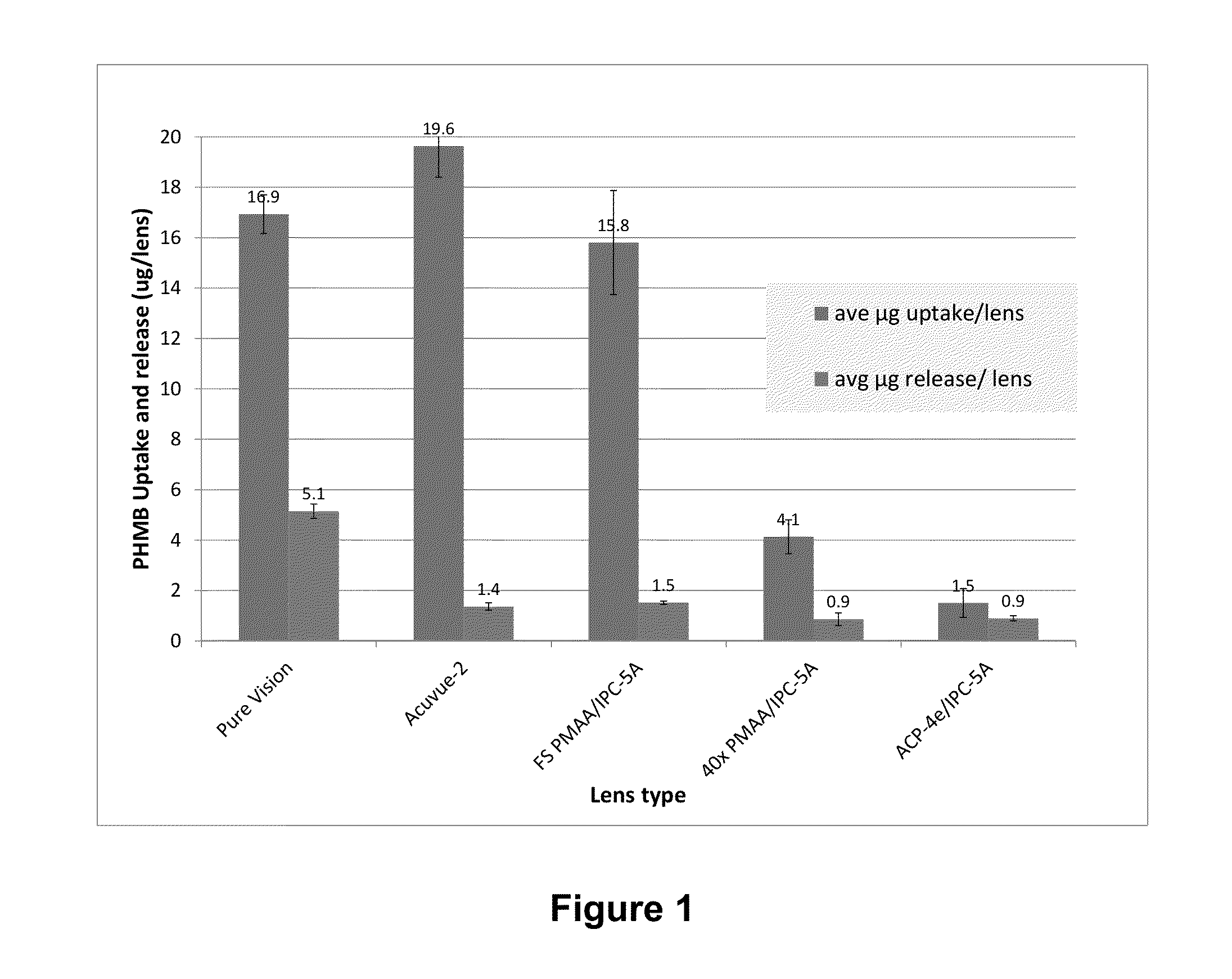Azetidinium-containing copolymers and uses thereof
a technology of copolymer and azetidinium, which is applied in the field of silicone hydrogel contact lenses, can solve the problems of haziness of the resultant lenses, low cost effectiveness of silicone hydrogel plasma treatment, and inability to provide a durable hydrophilic surfa
- Summary
- Abstract
- Description
- Claims
- Application Information
AI Technical Summary
Benefits of technology
Problems solved by technology
Method used
Image
Examples
example 1
Oxygen Permeability Measurements
[0139]The apparent oxygen permeability (Dkapp), the apparent oxygen transmissibility (Dk / t), the intrinsic (or edge-corrected) oxygen permeability (Dkc) of a lens and a lens material are determined according to procedures described in Example 1 of U.S. patent application publication No. 2012 / 0026457 A1 (herein incorporated by reference in its entirety).
Lubricity Evaluation
[0140]The lubricity rating is a qualitative ranking scheme where 0 is assigned to control lenses coated with polyacrylic acid (PAA), 1 is assigned to Oasys™ / TruEye™ commercial lenses and 5 is assigned to commercial Air Optix™ lenses. The samples are rinsed with excess DI water for at least three times and then transferred to PBS before the evaluation. Before the evaluation, hands are rinsed with a soap solution, extensively rinsed with DI water and then dried with KimWipe® towels. The samples are handled between the fingers and a numerical number is assigned for each sample relative ...
example 2
Synthesis of Diethyl Azetidinium Methacrylate Ester Chloride Salt (AZM) Monomer
[0149]2a. Synthesis of Diethyl Hydroxyl Azetidinium Chloride.
[0150]Diethyl amine (50 g, 0.686 mole) is dissolved in 25 mL of dry acetonitrile under argon. The solution is cooled down in an ice bath to 0° C. To this solution, epichlorohydrin (63.248 g, 0.684 mole) in 20 mL of dry acetonitrile is added. After the mixture is stirred at 0° C. for about 5 hours, the reaction is then performed at room temperature for another about 27 hours. The solid product is collected by filtration and washed with cold acetonitrile for a couple times. The typical yield is in the range from 30-50%.
2b: Synthesis of Diethyl Azetidinium Methacrylate Ester Chloride Salt (AZM).
[0151]In a Schlenk flask equipped with nitrogen flow, the obtained hydroxy azetidinium chloride salt (60 g, 0.362 mole) is dissolved in 336 mL of dry acetonitrile. To this solution, methacrylic acid anhydride (45.73 g, 0.297 mole) and di-tert-butyl-4-methylp...
example 3
Synthesis of in-Package Coating (IPC) Copolymers
[0152]3a. Preparation of AZM / APMA / PEG / DMA Containing Copolymer for IPC.
[0153]In a 500 mL glass reaction kettle, 5.0 grams of a solution of methoxy polyethylene glycol 2000 methacrylate (PEG2000-MA) (50% in water), 1.0 gram of aminopropylmethacrylamide (APMA), 1.0 gram of AZM prepared in Example 2, 5.47 grams of N,N′-dimethylacrylamide (DMA), and 3.00 mL of Irgacure 2959 solution (1% in water) are dissolved in 184.53 grams of 33.75 mM citrate buffer (pH 4). A lid is put onto the reaction kettle that contains at least 4 ground glass joints. One used for a glass stir shaft, one for a thermocouple, one for a nitrogen inlet, and one for sampling access. The solution is sparged with nitrogen for 20 minutes at about 200 mL / min. The nitrogen flow rate is reduced to about 150 mL / min. The stir speed is set to 150 rpm. The reaction kettle is put into a Rayonet UV reactor with RPR-3500 UV bulbs. Four UV bulbs are turned on for about 1 hour at an i...
PUM
| Property | Measurement | Unit |
|---|---|---|
| Temperature | aaaaa | aaaaa |
| Temperature | aaaaa | aaaaa |
| Temperature | aaaaa | aaaaa |
Abstract
Description
Claims
Application Information
 Login to View More
Login to View More - R&D
- Intellectual Property
- Life Sciences
- Materials
- Tech Scout
- Unparalleled Data Quality
- Higher Quality Content
- 60% Fewer Hallucinations
Browse by: Latest US Patents, China's latest patents, Technical Efficacy Thesaurus, Application Domain, Technology Topic, Popular Technical Reports.
© 2025 PatSnap. All rights reserved.Legal|Privacy policy|Modern Slavery Act Transparency Statement|Sitemap|About US| Contact US: help@patsnap.com



